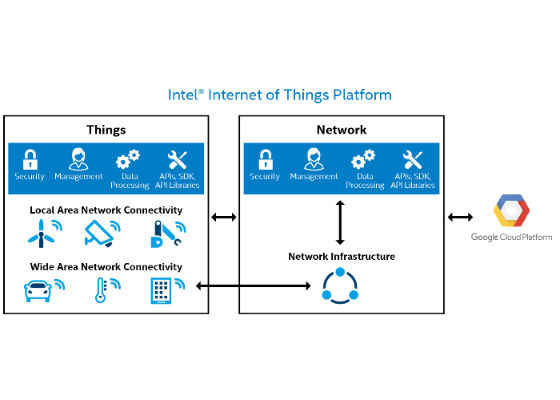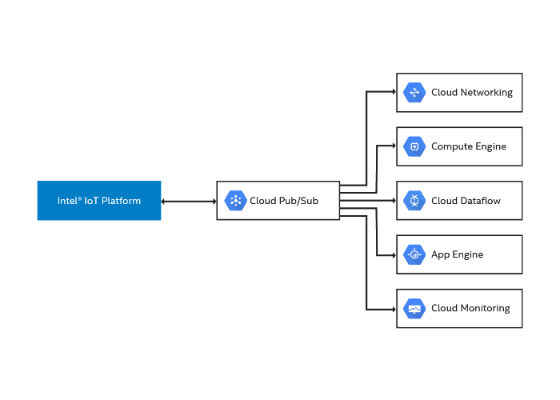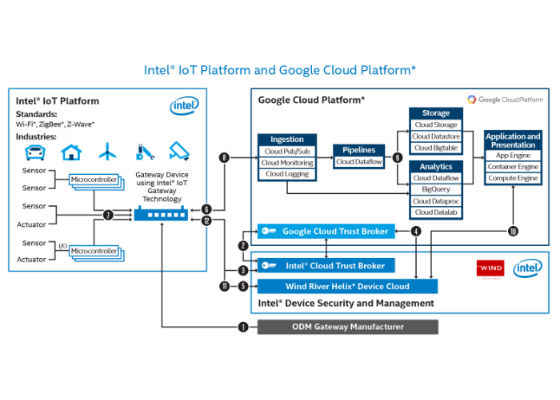Seamless Edge-to-Cloud IoT Integration Speeds Time to Market

Solution providers achieve end-to-end integration, deliver actionable customer insights, and gain a competitive advantage with the Intel® IoT Platform and Google Cloud Platform*
A fully integrated edge-to-cloud IoT infrastructure solution can help to improve business insights that provide a true competitive advantage.
Executive Summary
Organizations that rely on the Internet of Things (IoT) for critical business processes are looking for ways to merge data silos, reduce security risks, and eliminate duplicate infrastructure. A fully integrated edge-to-cloud IoT infrastructure solution can help to improve business insights that provide a true competitive advantage. But implementing security-focused edge-to-cloud IoT solutions can be complex. Organizations with multiple IoT implementations need a planned approach to help ease that complexity.
Intel and Google have worked together to deliver a standards-based approach to help IoT developers, OEMs, independent software vendors (ISVs), and system integrators (SI) develop seamless solutions. With a joint reference architecture built on the Intel® Internet of Things (Intel® IoT) Platform and the Google Cloud Platform* (GCP*), IoT providers can gain the following capabilities and benefits:
- Seamless data ingestion. With a standards-based reference architecture, data is easier to collect and devices are easier to control.
- End-to-end security. The architecture is designed to protect device hardware.
- Easy device onboarding. New devices can be automatically provisioned to platforms, providing security.
- Robust scalability. With Intel and Google technologies, organizations can scale rapidly on demand.
- Better insights. GCP’s analytics infrastructure with Intel’s analytics-at-the-edge capabilities can provide better insights for faster decision making, quicker time-to-market, and the opportunity to provide new services and solutions.
The Intel® IoT Platform and GCP joint reference architecture provides a comprehensive approach for connecting the device layer to the network layer and into the cloud.
Figure 1. The joint Intel and Google reference architecture makes connecting the Internet of Things (IoT) from edge-to-cloud easier, with a focus on security at every layer.
Introduction
The Internet of Things (IoT) is speeding data collection from connected devices and sensors, resulting in an explosion of new devices and sensors that are generating massive volumes of data. This data can help organizations make smarter decisions and bring new products and services to market faster. Gartner Research estimates that by 2020, 25 billion enterprise-owned Internet-connected things across the globe stand to generate up to USD 2 trillion in economic benefit.1 This presents tremendous opportunities for IoT solution providers, but developing an edge-to-cloud solution can be complex.
The technical challenges of IoT implementations often come from multiple IoT solutions dedicated to a variety of use cases within a single organization. These use cases can include monitoring chemical levels in manufacturing processes, occupancy-dependent lighting in offices, retail security cameras, or monitoring available parking. Multiple implementations also lead to a lack of interoperability between devices and equipment from different manufacturers. Successful IoT solutions require a deep understanding of infrastructure, security, integration, and interoperability from edge to cloud. Although IoT implementations can be complex, organizations and solution providers can eliminate much of the complexity and meet the growing IoT demand with integrated IoT solutions from Intel and Google.
Solution Architecture
The Intel® Internet of Things (Intel® IoT) Platform and the Google Cloud Platform* (GCP*) each provide capabilities and benefits that help IoT developers, OEMs, independent software vendors (ISVs), and system integrators (SIs) develop industry-standard, seamless solutions.
Solution Overview and Benefits
Together, the Intel IoT and GCP joint reference architecture seamlessly transmits data from sensors, actuators, and other endpoint devices to the Google* cloud. A clearly defined, standard reference architecture that details edge, network, and cloud components provides the following:
- Seamless data ingestion and device control for improved interoperability.
- Robust security for end-to-end data and device protection.
- Automated onboarding for simplified deployment of security-enabled devices.
- Robust scalability with cloud-based infrastructure.
- Customer insights through GCP’s analytics infrastructure.
- Data monetization through additional services and applications.
This joint reference architecture discusses:
- Intel IoT Platform. This illustrates the edge components, hardware security, and processors, as well as device provisioning, monitoring, and control.
- Google Cloud Platform (GCP). This illustrates the cloud services, including data ingestion, flow, storage, and analytics.
The joint reference architecture is followed by an implementation overview, as well as a logistics and asset management use case example in Appendix A: Logistics and Asset Management Use Case.
Intel® Internet of Things (Intel® IoT) Platform
The Intel IoT Platform (Figure 2) includes a family of Intel® products. The Intel IoT solution provider ecosystem delivers a foundation for easily connecting devices and delivering trusted data to the cloud. The Intel IoT Platform offers the following benefits:
- A broad array of devices. Intel’s ecosystem of original device manufacturers (ODMs) offers a wide range of devices and sensors built on Intel® technology.
- Security-focused solutions. Intel technology is designed for increased security at every layer, and includes zero-touch provisioning capabilities.
- Enhanced registration and management. With Wind River Helix* Device Cloud, device management and updates are seamlessly controlled from a central point in the cloud.
Figure 2. The Intel® IoT Platform connects a wide variety of devices to the cloud, using security-focused hardware and software solutions.
Google Cloud Platform* (GCP*)
GCP provides a security-enabled, cost-effective, and high-performance infrastructure in the cloud hosted through Google’s globally distributed data centers (Figure 3). Managed services provide access this infrastructure for an overall solution. The benefits include:
- Fully managed services. Google manages the setup and maintenance of the overall private infrastructure so customers can focus on building solutions.
- Integrated development experience. GCP provides a wide range of services for an integrated, end-to-end developer experience.
- Full control of the environment. Developers have full control of their computing environment, from data ingestion to presentation, through APIs in multiple languages.
- Broad scale and reach. GCP offers outstanding scale and reach, resulting in a computing and data platform that is uniquely positioned to address the challenges of IoT.
Figure 3. Google Cloud Platform* provides developers with full control of the environment without having to set up and manage the infrastructure.
Solution Architecture Details
The Intel IoT and GCP joint reference architecture (Figure 4) utilizes three primary types of components and solutions: Intel® Edge components, such as hardware security and processors; Intel® device and security management, such as device provisioning, monitoring, and control; and GCP cloud services, such as data ingestion, dataflow, storage, and analytics.
Intel® IoT Platform Components
Edge components
- Wind River Linux*. With built-in certifiable security capabilities and portability, Wind River* provides an IoT embedded Linux platform for hardware.
- Intel hardware-based security technologies. Capabilities such as secure boot, trusted execution environment (TEE), and Intel® Enhanced Privacy ID (Intel® EPID) provide security to the platform at the hardware level.
- Intel® architecture processors. Intel® Quark™ system on a chip (SoC) and the Intel Atom® processor, Intel® Core™ processor, and Intel® Xeon® processor families provide high performance and scalability.
Device and security management
- Wind River Helix* Device Cloud. Helix Device Cloud is an IoT portfolio of services and technologies that enable faster time to market; it provides device monitoring, control, software updates, registration, attestation, and security-enabled deployment at scale.
- Intel® Zero-Touch Device Onboarding. Using the privacy-preserving properties of Intel EPID—an IoT identity standard—and new onboarding protocols, owners can automatically register with their devices in GCP when powered on.
GCP Components
GCP components may vary depending on implementation and are grouped into five primary functions:
Data ingestion
- Cloud Pub/Sub*. Cloud Pub/Sub provides a fully managed, real-time messaging service that allows developers to send and receive messages between independent applications.
- Cloud Stackdriver Monitoring*. Cloud Monitoring provides visibility into the performance, uptime, and overall health of cloud applications.
- Cloud Stackdriver Logging*. Cloud Logging allows developers to store, search, analyze, and monitor log data and events, as well as to send alerts.
Pipelines
- Cloud Dataflow*. Cloud Dataflow is a unified programming model the provides managed services for developing and executing a wide range of data processing patterns including extract, transform, load (ETL) and batch and continuous computation. Cloud Dataflow frees developers from operational tasks, such as resource management and performance optimization.
Storage
- Cloud Storage*. GCP provides an object store solution for excellent IoT performance and price.
- Cloud Datastore*. Cloud Datastore is a NoSQL database that is ideally suited for mobile and web endpoints.
- Cloud Bigtable*. Cloud Bigtable is designed for workloads that require higher speed and lower latency, such as analytics.
Analytics
- Cloud Dataflow*. Dataflow provides programming primitives, such as powerful windowing and correctness controls, that can be applied across both batch- and stream-based data sources.
- BigQuery*. BigQuery is a fully managed, petabyte-scale, low-cost enterprise data warehouse for analytics.
- Cloud Dataproc*. For Apache Spark* and Apache Hadoop*, Cloud Dataproc is designed for open source data tools for batch processing, querying, streaming, and machine learning.
- Cloud Datalab*. Cloud Datalab is an interactive tool for exploring, analyzing, and visualizing data with a single click.
Application and presentation
- App Engine*. App Engine is a platform-as-a-service (PaaS) solution used to develop applications without concern for the underlying infrastructure.
- Container Engine*. Container Engine is a managed Kubernetes* solution that provides industry-specific solutions, such as fleet management.
- Compute Engine*. Compute Engine is an infrastructure-as-a-service (IaaS) product that offers VMs on a variety of guest operating systems.
Figure 4. The Intel® IoT Platform and GCP* joint reference architecture details the connections for seamless device onboarding and ownership privacy.
Implementation Overview
The process of connecting devices, integrating data, and managing software upgrades follows these steps (Figure 4):
Onboarding Devices
1. During manufacturing, the silicon provider embeds Intel EPID credentials in a TEE of the processor. The ODM uses an open source toolkit from Intel to create a global unique identifier (GUID), assign a rendezvous URL for the device to “phone home” to get its new owner information, and generate an ownership proxy that is used to cryptographically verify ownership of the device by GCP.
2. Upon purchase, along with the purchase receipt, an ownership proxy for the device is generated. The owner imports the ownership proxy into GCP, which then signals to the Intel® cloud trust broker—a rendezvous service that directs a device to its new owner.
3. When the device is powered on the first time, it “phones home” to the Intel cloud trust broker, which redirects it to the IP address provided by its new designated GCP owner.
4. The GCP trust broker and gateway verify the device through its Intel EPID signature and ownership proxy, and then register the device for management with the GCP and Wind River Helix Device Cloud.
5. The Wind River Helix Device Cloud distributes the device certificate provided by the GCP and configures the pub/sub topic subscriptions on the gateway.
6. The GCP IoT SDK on the gateway authenticates the GCP using the device certificate and establishes a data path to the GCP.
Collecting and Integrating Data
1. Business applications on the gateway acquire data from connected sensors through a number of supported protocols, such as Z-Wave*, ZigBee*, and Bluetooth® technology.
2. The GCP IoT SDK on the gateway transmits sensor data to the GCP through pub/sub messaging protocols.
3. Data messages are routed, processed, stored, and made available for enterprise integration.
Managing Devices and Software Updates
1. Application software managers push updates to the Wind River Helix Device Cloud using APIs.
2. The Wind River Helix Device Cloud prepares signed RPM packages and pushes them to the gateway.
3. The management agent on the gateway of the Intel IoT Platform upgrades the software.
Summary
Intel and Google’s end-to-end joint reference architecture for IoT offers a robust, security-enabled, yet simplified solution that gives IoT developers the tools and services to create high-performance solutions. With security-enabled, scalable interoperability, the Intel IoT and GCP joint reference architecture can provide the building blocks for any IoT application in any industry.
The joint reference architecture is reusable, preconfigured, and prevalidated. It can connect devices with zero touch and deliver trusted data with interoperable hardware and software from the edge to the cloud. Each layer is designed with a focus on security and scalable hardware built on Intel technology is optimized for performance across workloads.
For more such intel IoT resources and tools from Intel, please visit the Intel® Developer Zone
Source: https://software.intel.com/en-us/articles/seamless-edge-to-cloud-iot-integration-speeds-time-to-market








